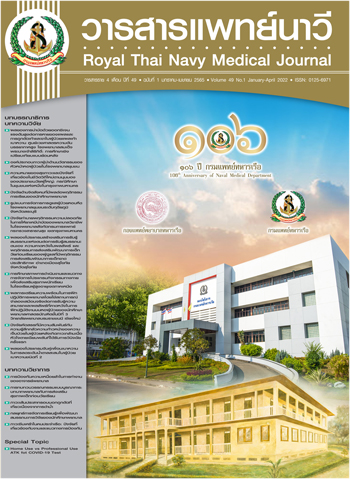The Effects of Hyperbaric Oxygen Therapy on Wound Healing and Amputation of Feet and Legs in Patients with Diabetic Foot Ulcers at Hyperbaric Medical Center, Somdej Pranangchaosirikit Hospital: A Comparative Retrospective Study
Main Article Content
Abstract
A retrospective comparative research aimed to study and compare the rate of diabetic wound healing and the rate of foot and leg amputations between patient with diabetic foot ulcer who were treated with conventional therapy and the combined conventional therapy with hyperbaric oxygen therapy (HBOT).
The sample consists of 114 type 2 diabetic patients with Wagner grade 3 - 4 at Somdej Pranangchaosirikit Hospital during 2016 - 2020, which were devided into 2 groups. A group of 57 patients received conventional therapy and 57 patients received the combined conventional therapy with HBOT. The research instrument was a medical record with content validity index of 0.80. Data were analyzed using descriptive statistics and chi-square statistics. The results revealed that:
1) The rate of wound healing was 91.23% in HBOT group and 89.47% in conventional therapy group. Meanwhile, there was no statistically significant difference in the proportion of wound healing between the two groups.
2) The rate of foot and leg amputation was 49.12% in HBOT group and 70.18% in conventional therapy group. For comparison, the proportion of foot and leg amputation between HBOT group was lower than conventional therapy group with statistical significance at .05 level. Patients with diabetic foot ulcers who received the combined conventional therapy with HBOT had a 30 percent lower risk of foot and leg amputations.
Article Details

This work is licensed under a Creative Commons Attribution-NonCommercial-NoDerivatives 4.0 International License.
References
Thai National Health Examination Survey V Study Group. Thai National Health Examination Survey, NHES V. Nonthaburi, Thailand: National Health Examination Survey Office, Health System Research Institute; 2016. (in Thai).
Diabetes Association of Thailand under The Patronage of Her Royal Highness Princess Maha Chakri Sirindhorn. Clinical practice guideline for diabetes. [Internet]. [cited 2019 August 8]. Available from: http://www.dmthai.org. (in Thai).
Bureau of Policy and Strategy, Office of The Permanent Secretary Ministry of Public Health. The number and rate of diabetes patients (E10-E14). [Internet]. [cited 2019 August 11]. Available from: http://thaincd.com/information-statistic/ non-communicable-disease- data.php. (in Thai).
Namvongprom A, Pakdevong N. Foot ulcers and factors relating to foot ulcers in person with type 2 diabetes. Thai Journal of Nursing Council 2010;25(3):51-63. (in Thai).
Boulton AJ, Vilkeite L, Ragnarson-Tennall G, Apelqvist J. The global burden of diabetic foot disease. Lancet 2005;366:1719-24.
Krittiyawong S, Ngamrukos C, Benjasuratwong Y, Rawdaree P, Leelawatana R, Kosachunhahun N, et al. Thailand diabetes R=registry project: prevalence and risk factors associated with lower extremity amputation in Thai diabetics. J Med Assoc Thai 2006;89(Suppl 1):S43-8. (in Thai).
Lipsky BA, Berendt AR, Cornia PB, Pile JC, Peters EJ, Armstrong DG, et al. Infectious Diseases Society of America clinical practice guidelines for the diagnosis and treatment of diabetic foot infections. Clin Infect Dis 2012;54:132-73.
World Health Organization. Global report on diabetes. Geneva: World Health Organization; 2016.
Most RS, Sinnock P. The epidemiology of lower extremity amputations in diabetic individuals. Diabetes Care 1983;6:87-91.
McGrath T, Hamilton R. Hyperbaric oxygen in the treatment of venomous snake bites. UHM 2010;37:393-4.
Silpsrikul P. Treatment of Malayan pit viper bite with Hyperbaric Oxygen Therapy. Royal Thai Navy Medical Journal 2014;41(3):75-88. (in Thai).
Brölmann FE, Ubbink DT, Nelson EA, Munte K, van der Horst CM, Vermeulen H. Evidence based decisions for local and systemic wound care. Br J Surg 2012;99(9):1172-83.
Information Office. Somdej Pranangchao Sirikit Hospital. Diabetic foot ulcers statistics. Chonburi: Somdej Pranangchao Sirikit Hospital; 2019. (in Thai).
Undersea and Hyperbaric Medicine Society. Hyperbaric oxygen therapy indications 12th ed. FL: Undersea and Hyperbaric Medicine Society; 2008.
Wattel F, Marroni A, Mathieu D. European Committee for Hyperbaric Medicine (ECHM) to coordinate, promote and study the development of clinical hyperbaric medicine in Europe. Minerva Anestesiol 2000;66(10):733-48.
Cohen J. Statistical power analysis for the behavioral sciences. NY: Routledge Academic; 1988.
Seelacharoern N. Predictive factors for lower extremity amputation in diabetic mellitus type 2 patients with diabetic foot ulcers in Deoermbangnangbuat district, Suphunburi province. Journal of The Department of Medical Service 2017;42(2):58-67. (in Thai).
Imran S, Ari R, Mahboob G. Frequency of lower extremity amputation in diabetics with reference to glycemic control and wagner’s grades. J Coll Physicians Surg Pak 2006;16:124-7.
Tongson L, Habawel D L, Evangelista R, Tan J L. Hyperbaric oxygen therapy as adjunctive treatment for diabetic foot ulcers. Wounds International 2013;4(4):8-12.
Zhao D, Luo S, Xu W, Hu J, Lin S, Wang N. Efficacy and safety of hyperbaric oxygen therapy used in patients ith diabetic foot: a meta-analysis of randomized clinical trials. Clinical Therapeutics 2017;39(10):2088-94.e2.
Erdoğan A, Düzgün A P, Erdoğan K, Özkan M B, Coşkun F. Efficacy of hyperbaric oxygen therapy in diabetic foot ulcers based on wagner classification. The Journal of Foot and Ankle Surgery 2018;57(6):1115-9.
Baroni G, Porro T, Faglia E, Pizzi G, Mastropasqua A, Oriani G, et al. Hyperbaric oxygen in diabetic gangrene treatment. Diabetic Care 1987;10(1):81-6.
Oriani G, Meazza D, Favales, Pizzi G L, Aldeghi A, & Faglia E. Hyperbaric oxygen in diabetic gangrene. Journal of Hyperbaric Medicine 1990;5:171-5.
Faglia E, Favale F, Aldeghi A, Calia P, Quarantiello A, Oriani G, et al. Adjunctive systemic hyperbaric oxygen therapy in treatment of severe prevalently ischemic diabetic foot ulcer. Diabetes Care 1996;19(12):1338-43.

